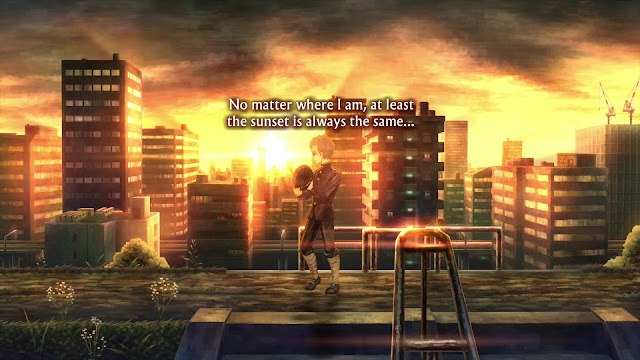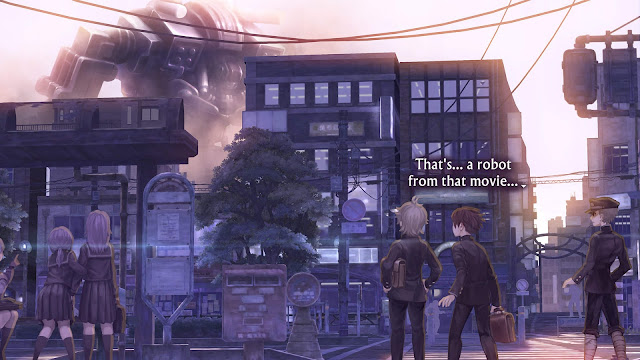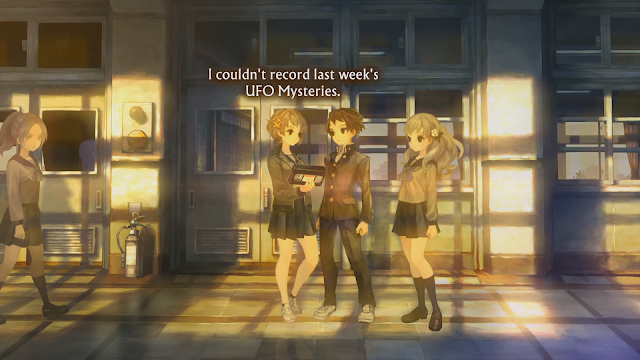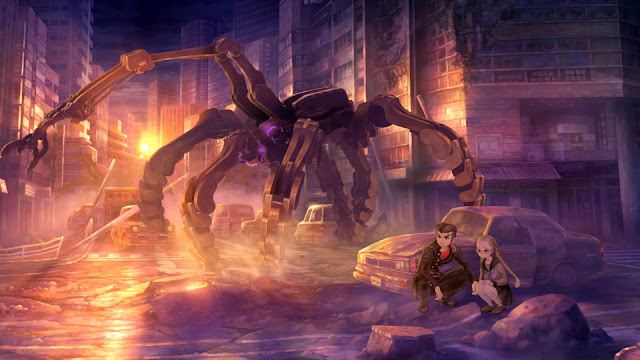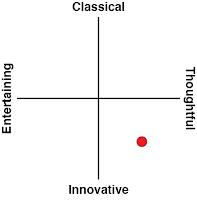What a wonderful thing 13 Sentinels: Aegis Rim is. Developer, Vanillaware, is known for its quality 2D action games, from Dragon’s Crown through to Odin Sphere, but in general, those games are about the stunning visual engines and tight action. The developer has never been known as a storyteller in the main (yes, it tells excellent stories, but they’ve always been secondary and in service of the gameplay). That reputation will surely change with 13 Sentinels, though. That’s not to diminish the quality of the tactical strategy side of the game, because it’s really good. Rather, it’s merely to acknowledge that Vanillaware has achieved something quite special, and dare I say literary, as a narrative experience here.
Rarely is a game broken down so completely into “narrative bits” and “gameplay bits”, but that’s exactly what 13 Sentinels does. Once you’ve worked through the prologue (i.e. tutorial), you’re taken to a menu, where the tactical strategy “gameplay” is one option, and a visual novel-like “narrative” option is another. The two are related (completing parts of one unlocks things in the other), but there’s a refreshing lack of pretence about integrating two things that are, really, very distinct to one another.
Jump into the gameplay section, and you’ll find yourself tasked with forming teams from among the thirteen principal characters, and then using them to repel waves of attackers in what is effectively a highly stylised tower defense combat system. Characters and enemies are represented as little icons on a top-down topographic map of various parts of the city, and your job is to prevent the enemies from attacking a tower located in one part of that. Some enemies are fliers, while others are more vulnerable to melee attacks than ranged missiles, and naturally, your team has a range of specialisations and weapon capabilities across the thirteen of them. It’s been a long while since the tower defence genre was tackled in a serious way (especially outside of the mobile space), but 13 Sentinels has reminded us that, in application, it can be so much more than a casual “easy-playing” variation on strategy.
Indeed, turn the difficulty level up on 13 Sentinels, and it will make you sweat. It’s turn-based, in the sense that each character works on a countdown, and once it’s their “turn” again, you can take as long as you need to give them instructions. But after you do that, the action plays out in real-time until another one of your characters has had their timer count down, and there can be some really tense moments in waiting for another set of turns to roll around again. On the higher difficulty levels, you really need to master everything, from unit placement, through to the timing on when you activate abilities and how to best use the full gamut of equipment and upgrades available to you (as well as knowing which characters to take into each battle based on their unique strengths and capabilities). The prologue battles make the whole experience seem simplistic and limited, but once you’re deep into 13 Sentinels proper, you’ll find yourself pouring over every element to try and figure out how to push through.
And that’s the weaker side of 13 Sentinels. The banter between the various characters before and after battles is exactly what you’d expect for a science fiction robots-vs-kaiju storyline, and a lesser developer would have started, and stopped, with that being the entirety of the game. It would have been more than enough if that was all the game offered. It’s the other menu, with the visual novel bit, where 13 Sentinels really fascinates, delights, and may just move you to the point of tears.
Right from the outset, 13 Sentinel’s narrative comes across as ambitious to the point of being unwieldy – you actually experience the narrative from the perspective of all thirteen main characters, and you have a lot of freedom in the order that you experience the story. If you’re like me, for example, you’ll go through every moment of a favourite character’s narrative arc that you can (Iori, of course. Dear God is Iori pretty), before then viewing events and relationships through the lens of a different character. Some sections and characters are locked away until you have seen things with another character (or completed specific combat events), but in general, you’ve got a lot of room to work with perspectives in 13 Sentinels.
This is already an incredibly complex narrative task. With every additional perspective, a writer needs to find a way to gain the player’s emotional and intellectual involvement with a character. Likewise, it’s important to show different characters and situations in different lights, based on the character that’s currently the protagonist, and this kind of highly subjective approach to perspective in scene writing is difficult. Most great writers struggle to structure a single character’s perspective well. And then, like hurling a drum of gasoline on an already raging wildfire, Vanillaware’s team also introduce time travel (to be cryptic here for a moment – people are going to come back to this review and yell at me for not playing it to completion, but I have and yes, I know. Talk to the publisher about their spoilers rules) and an impending apocalypse (see above note) into the mix. The result is dense, complex, and intellectually challenging to follow, with a thematic density that we very rarely see in videogames.
I need to be broad here, because of course the embargo restrictions are ridiculously restricted and we live in a world where every single line of dialogue is somehow a potential spoiler – and I really am being very handcuffed here in talking about the game’s deeper themes and narrative thrust, but it should be pretty clear what deeper themes the developers are working towards when the narrative end-point is an apocalypse, when time travel’s introduced as a potential solution to that end-point, and you’re presented with a large ensemble cast of characters with some wildly divergent motivations; 13 Sentinels is a pretty hefty take on deterministic philosophy.
For those unfamiliar with the term, determinism is the theory that all events – including the kind of moral choices that we believe we make out of free will – is actually determined by previously existing causes. It is, effectively, the idea that nothing happens that wasn’t already going to happen, and humans cannot behave in any other way aside from how they already behave. “Human beings, vegetables, or cosmic dust, we all dance to a mysterious tune, intoned in the distance by an invisible piper” as Albert Einstein once so poetically put it.
Determinism is a singularly dense kind of philosophy to grapple with, but that hasn’t stopped many (many) video games for effectively putting arguments forward around it, even if they aren’t always aware of doing so. Final Fantasy and its crystals and heroes fated by destiny to save the world is a deterministic series, and it took right up until the Final Fantasy XIII trilogy to really challenge that idea (and then, as we all discovered, determinism is complex and in grappling with the topic, the FFXIII trilogy confused a lot of people to the point where they found the trilogy bewildering). Video games, by virtue of the fact that they’re consumed via a controller in the hands, are singularly effective at exploring the tension between determinism and free will, but rarely has a game handled it at the core quite like 13 Sentinels.
What I found particularly impressive about 13 Sentinels is just how actively it subverts itself, constantly setting up expectations about key plot points, characters, relationships and interactions, only to undermine itself to greater thematic effect. Structurally this is only possible because of the ensemble cast approach, but if it were attempted by less mature writers, this would have come across as a laboured series of arbitrary and nonsensical “gotya” moments, as happens far too often in the games industry when writers give “subversion” a whirl. Vanillaware’s writers have, instead, created almost a “question and answer” approach to just about everything that you see and do through the game. What initially can be taken for granted becomes something that you yourself are encouraged to question before learning the ultimate truth of the matter. It’s a much more nuanced effort as a result. There are “subversive” games that are more shocking in the revelations because the twists act like 180s. Those are inferior as subversive works. To 13 Sentinels, the subversion is inherent and integrated into the very narrative fabric.
This is a game that, much like NieR Automata, can (and really should) leave you in a deeply reflective mood and, ideally, interested in looking further into the complex ideas that it explores. However, much like NieR Automata, it also doesn’t forget that it needs to be entertaining. The complex web of relationships that are at play within 13 Sentinels are fascinating, and the game runs the gamut from deep intensity to the lightest of levity. From yakisoba-pans to (very deliberate and contextually appropriate) fan service humour, this is also a game that revels in being a Japanese anime-aesthetic game… and of course there’s some meta-subversion going on in how it handles that, too. Finally, the pacing is spot on – 13 Sentinels is a fairly lengthy game by necessity at some 25 or so hours, but it never allows itself to slow to a crawl in order to pad itself out with yet more content, either.
I know I’m being vague in what I write and say here, but I really am restricted from talking about the best that 13 Sentinels offers by embargo conditions. What I can say, however, is that this game stands proudly with the likes of NieR Automata, Persona 4 and Danganronpa as something truly intelligent and meaningful. Without ever losing sight of its need to entertain players, 13 Sentinels intellectually engages with and challenges them, respecting their ability and willingness to engage with the game on that level. It is, in a games industry that increasingly frustrates me for its lack of artistic intent, deeply and proudly artistic. The fact that it just happens to have such an excellent strategy game layered over the top of the narrative is the nicest icing on the cake.
– Matt S.
Editor-in-Chief
Find me on Twitter: @mattsainsb
The critic was provided a code for the purposes of review.


